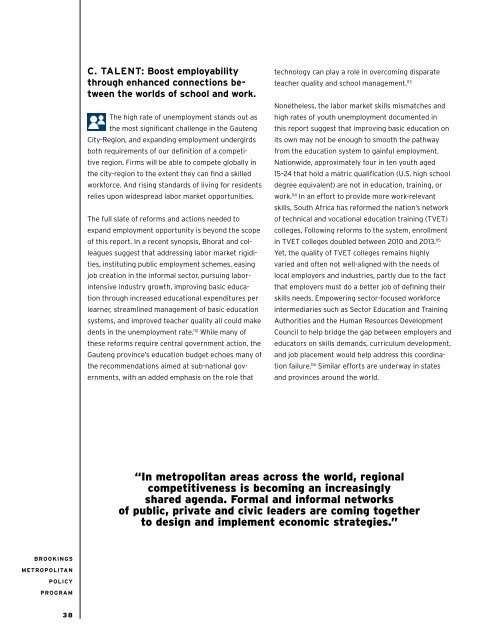SOUTH AFRICA’S
1HAwfit
1HAwfit
You also want an ePaper? Increase the reach of your titles
YUMPU automatically turns print PDFs into web optimized ePapers that Google loves.
C. TALENT: Boost employability<br />
through enhanced connections between<br />
the worlds of school and work.<br />
The high rate of unemployment stands out as<br />
the most significant challenge in the Gauteng<br />
City-Region, and expanding employment undergirds<br />
both requirements of our definition of a competitive<br />
region. Firms will be able to compete globally in<br />
the city-region to the extent they can find a skilled<br />
workforce. And rising standards of living for residents<br />
relies upon widespread labor market opportunities.<br />
The full slate of reforms and actions needed to<br />
expand employment opportunity is beyond the scope<br />
of this report. In a recent synopsis, Bhorat and colleagues<br />
suggest that addressing labor market rigidities,<br />
instituting public employment schemes, easing<br />
job creation in the informal sector, pursuing laborintensive<br />
industry growth, improving basic education<br />
through increased educational expenditures per<br />
learner, streamlined management of basic education<br />
systems, and improved teacher quality all could make<br />
dents in the unemployment rate. 112 While many of<br />
these reforms require central government action, the<br />
Gauteng province’s education budget echoes many of<br />
the recommendations aimed at sub-national governments,<br />
with an added emphasis on the role that<br />
technology can play a role in overcoming disparate<br />
teacher quality and school management. 113<br />
Nonetheless, the labor market skills mismatches and<br />
high rates of youth unemployment documented in<br />
this report suggest that improving basic education on<br />
its own may not be enough to smooth the pathway<br />
from the education system to gainful employment.<br />
Nationwide, approximately four in ten youth aged<br />
15–24 that hold a matric qualification (U.S. high school<br />
degree equivalent) are not in education, training, or<br />
work. 114 In an effort to provide more work-relevant<br />
skills, South Africa has reformed the nation’s network<br />
of technical and vocational education training (TVET)<br />
colleges. Following reforms to the system, enrollment<br />
in TVET colleges doubled between 2010 and 2013. 115<br />
Yet, the quality of TVET colleges remains highly<br />
varied and often not well-aligned with the needs of<br />
local employers and industries, partly due to the fact<br />
that employers must do a better job of defining their<br />
skills needs. Empowering sector-focused workforce<br />
intermediaries such as Sector Education and Training<br />
Authorities and the Human Resources Development<br />
Council to help bridge the gap between employers and<br />
educators on skills demands, curriculum development,<br />
and job placement would help address this coordination<br />
failure. 116 Similar efforts are underway in states<br />
and provinces around the world.<br />
“In metropolitan areas across the world, regional<br />
competitiveness is becoming an increasingly<br />
shared agenda. Formal and informal networks<br />
of public, private and civic leaders are coming together<br />
to design and implement economic strate gies.”<br />
BROOKINGS<br />
METROPOLITAN<br />
POLICY<br />
PROGRAM<br />
38


